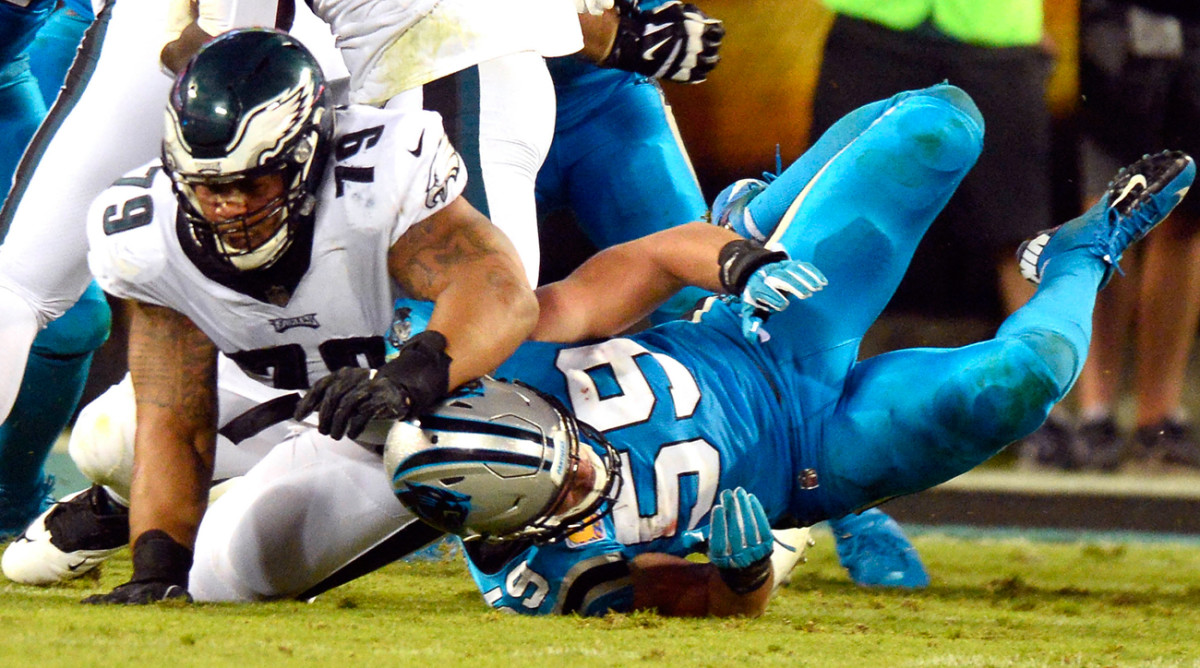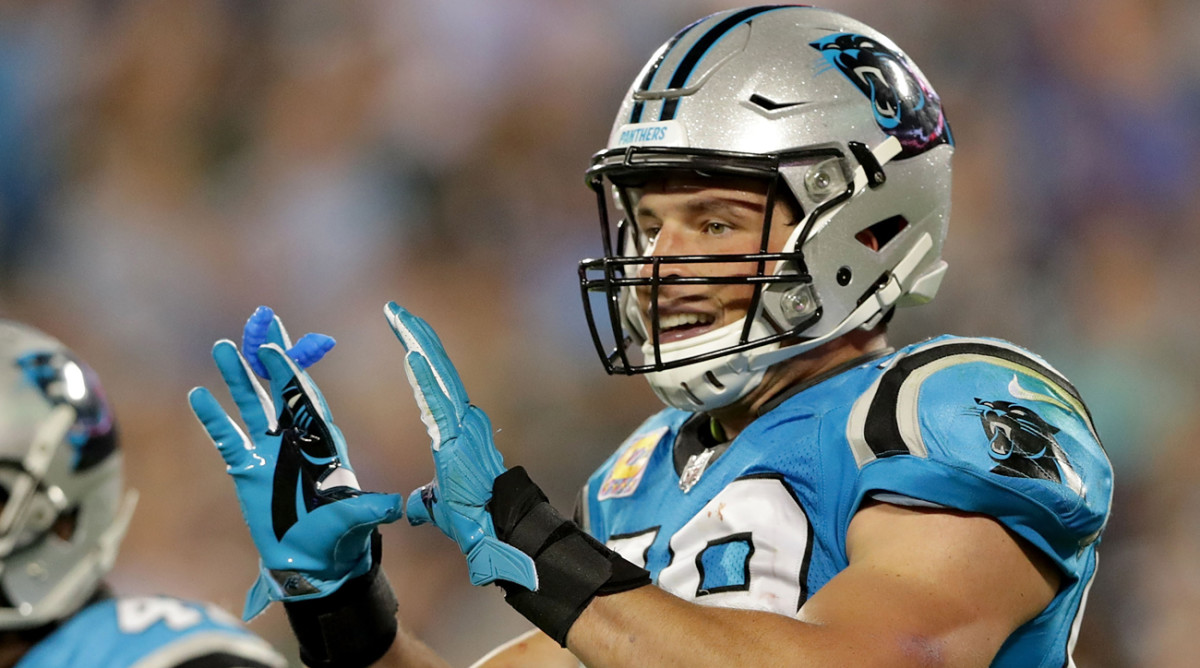Luke Kuechly Is the Poster Child for the NFL’s Concussion Problem

Luke Kuechly has become the poster child of the concussion problem in the NFL.
The problem itself is not new; concussions in this sport have been an issue for decades. But there are more tentacles than ever, and Kuechly seems to be at the intersection of all of them. There’s the problem with identifying exactly what a concussion is. There’s the problem of understanding the “concussion protocol,” a term barely comprehended by the sport’s fans and only nominally more so by its media. There’s the issue of figuring out how many concussions Kuechly, 26, has really had in three NFL seasons. There’s deciphering the degree to which the concussions themselves really matter as opposed to the effects of other impacts. And there’s the wondering if we’re all missing the forest for the trees, since it’s easier and catchier to say “three concussions in three seasons” than to grasp that there could be far more to Kuechly’s situation.
First, the hit. In the second quarter of the Thursday night Panthers-Eagles game, Philly guard Brandon Brooks blocked Kuechly in the backfield. The impact was hard but routine. At first glance, Brooks’ upper arm/shoulder area appeared to hit Kuechly in his left shoulder. On closer glance, Brooks’ arm made more contact with the left side of Kuechly’s helmet, and as the linebacker went to the ground and Brooks finished the hit, Brooks appeared to strike the left side of Kuechly’s head again.

On the sideline, Kuechly was attended to by head athletic trainer Ryan Vermillion and team doctor Robert Heyer. Kuechly worked out his neck as you would on a morning after you sleep on it incorrectly. Eventually he jogged into the locker room, and not one of his teammates would see him until the next day, when he was already in the protocol.
The entire event felt so … routine.
“If Luke Kuechly has in fact suffered a concussion, then a third in three years puts him into a precarious situation,” Dr. Kevin Guskiewicz wrote to me in an email in the hours after Kuechly entered the concussion protocol. “What the research has taught us is that once you have had three concussions, especially over a relatively short period of time, you are at risk for a slower recovery and an increased risk for subsequent concussions.”
Guskiewicz is a neuroscientist who serves as the dean of the College of Arts and Sciences at UNC Chapel Hill. Along with being the co-director of the Sport-Related Traumatic Brain Injury Research Center and a 2011 MacArthur genius grant recipient, Guskiewicz has also served on the NFL’s head, neck and spine committee.
“More worrisome is that our studies at UNC’s Center for the Study of Retired Athletes have shown that former professional players with three-plus concussions are at an increased risk for depression and mild cognitive impairment later in life,” Guskiewicz continued. “It’s a shame, because I have followed his amazing career and his injuries. I know he has received very good care by the Panthers’ medical staff, as they have been very conservative in managing his last two concussions. He just seems to be vulnerable, and I fear that this will continue to be the case.”
The UNC studies, based on what’s called the dose-response relationship, has shown that three or more concussions has a greater association with poor outcomes. Those mild cognitive impairments involve early memory problems and the beginnings of changes in executive functioning, Guskiewicz said.
To Guskiewicz’s point, the Panthers have indeed been conservative with Kuechly. When he suffered his first concussion, in the 2015 season opener, he missed three games. Last season when he suffered his second concussion—a scary and emotional scene in which he had an uncontrollable burst of tears on the field—he missed the final six games though he was cleared to play after three.
As I wrote after his second concussion, Kuechly is not naïve to the dangers of the sport. I’m confident he’s read more about concussions than I have. He sought multiple professional opinions, including going to Pittsburgh to consult with specialist Micky Collins. This season he’s worn a Q Collar, an experimental device around the neck that’s intended reduce the risk and or severity of concussions.
In Charlotte, Kuechly can’t avoid comparisons to Dan Morgan, the former first-round linebacker and tackling machine who suffered at least five diagnosed concussions (and by his own admission many more undiagnosed) during a career that was cut short at age 29 by shoulder, Achilles and head injuries.
“I think when you play a contact sport there’s always inherent risk and inherent risk to injury,” Kuechly told ESPN Charlotte radio during a training camp interview this summer after spending most of the offseason choosing not to discuss concussions. “At what point do you tolerate it, and at what point is it enough? There’s been a lot of studies and a lot of different literature on concussion and head trauma and that kind of deal, and I think it’s a new subject that we’re constantly learning more and more about.”
What we can all say fairly certainly is that getting into 60 or so violent collisions within three hours on a Sunday—and then doing it again four days later, as the Panthers and Eagles did—is not good for the body or the brain.
So you could imagine my surprise when Dr. Robert Stern, a neuroscientist and the Director of Clinical Research for Boston University’s Chronic Traumatic Encephalopathy (CTE) Center, told me on Friday, that concussions by themselves “are not that awful.” He’s quick to point out that he’s not a concussion specialist but an expert on the neurodegenerative disease known as CTE.

Stern, speaking from from Washington, D.C., following a congressional meeting on the long-term effects of football hits, told me concussions themselves are manageable if treated properly, if the person is allowed enough time to recover fully and if there isn’t continued stress on the brain.
“Three concussions isn’t necessarily a lot,” Stern says. “I think those are ones that you know of and that most other players probably have had lots of concussions also in that same time period. The key is whether he takes a longer period of time to recover from each concussion, how severe the symptoms are and whether they are coming more frequently with each subsequent concussion. Those are all key issues.
“The big elephant in the room that people don’t seem to deal with is, do those increased hits mean that he’s at increased risk for later-life problems like CTE? And concussions themselves are not really the big issue when it comes to CTE. It’s really the overall exposure to repetitive impacts, the subconcussive trauma. We don’t think the number of concussions, per se—which are symptomatic mild brain injuries—are the big issues. It’s the repetitive issue of getting hit over and over and over and over again without the rest and recovery of someone who has a diagnosed concussion. So I’m not trying to belittle in any way the issue of three concussions in the last two and a half years. That’s important, and I think the key though is that he’s probably not alone.”
And so here’s the forest for the trees argument. Are we so focused on the all-world linebacker getting three concussions in three seasons (and, more specifically, in 26 months) that we ignore the possible greater issue of subconcussive trauma? If a renowned neuroscientist saying three concussions “isn’t necessarily a lot,” consider how jarring this is:
“I’m not going to say how many concussions are the maximum,” Stern says. “I’m not even going to say what is a concussion.”
What Stern means is, there is no single, objective scientific method of diagnosing a concussion, a condition that may have no outward symptoms and might take hours or days to manifest itself. Rather, doctors use a handful of subjective evaluations, including cognitive tests and checks of vision, hearing and coordination, as well as imaging. Not to say progress isn’t being made toward a definitive diagnostic tool. Researchers may be close to using biomarkers in the blood that are associated with head trauma to diagnose a concussion, gauge its severity and track recovery. Improvements to cognitive, balance and vision tests over the past decade-plus have also helped in that regard, and next Tuesday there will be a summit in Boston with some of the country’s top neuroscientists that explores these advances and links between concussions and CTE, along with other diseases. Still, we rely on players’ willingness to acknowledge that they have a problem and to report their symptoms. We have different people, all well-meaning and qualified, evaluating these players. What constitutes a concussion according to the NFL may not be the same as the NHL or FIFA. There are so many variables involved here.
This is the concussion problem for which Kuechly is the poster child. A day after he was placed in the concussion protocol, his defensive coordinator told reporters that he was “perfectly fine in the conversation I had.” Were the Panthers just being (overly) cautious with Kuechly because of his history, or did he really suffer another concussion? That question was further clouded on Sunday morning when ESPN’s Adam Schefter reported that Kuechly did not suffer a concussion and had already been cleared through the protocol. The report was quickly refuted by Panthers PR chief Steven Drummond, who tweeted that Kuechly was still in the protocol and nothing had changed.
If Kuechly, the 2013 Defensive Player of the Year, has suffered three concussions, is that enough to stop his lifelong dream of playing this sport? He’s the best middle linebacker in football, on a team built for sustained success, and he’s on track to be a Hall of Famer. Who are we to tell him to stop when we will still be watching if he gets a fourth?
• SIGN UP FOR THE MMQB NEWSLETTER: Get the latest NFL news and the best of The MMQB delivered to your inbox every morning.
• Question or comment? Email us at talkback@themmqb.com
